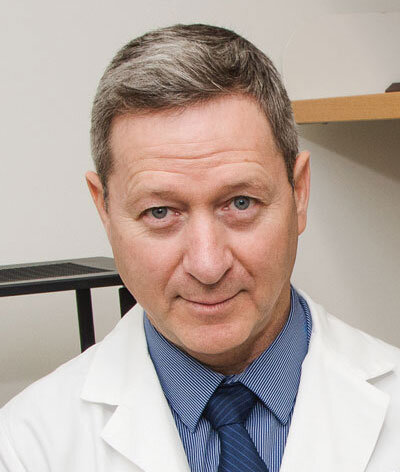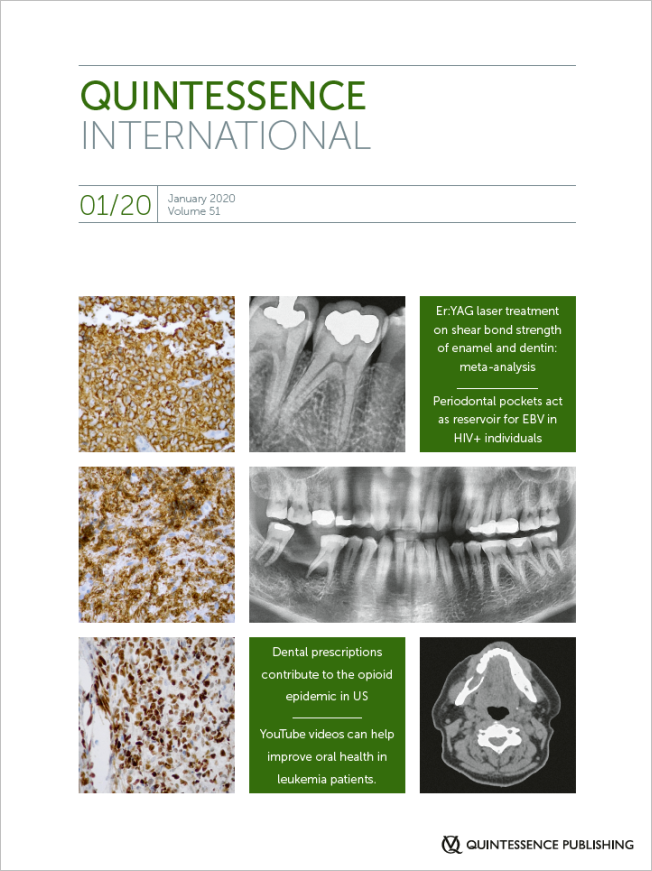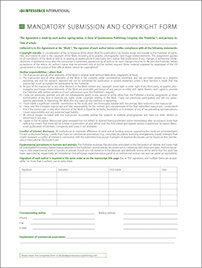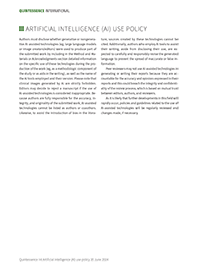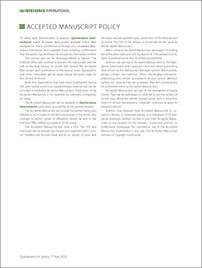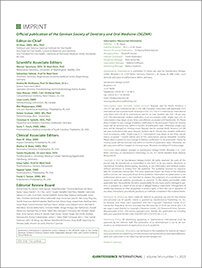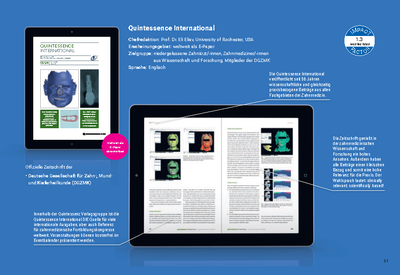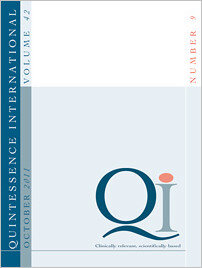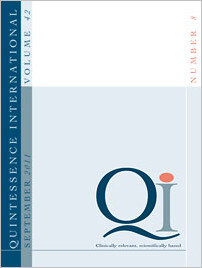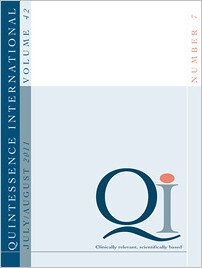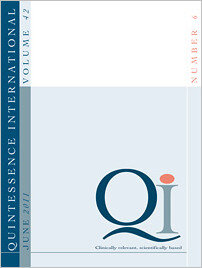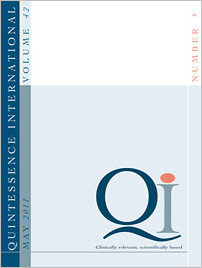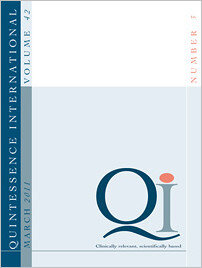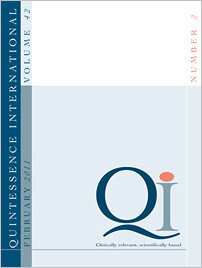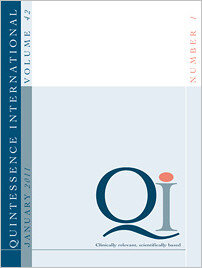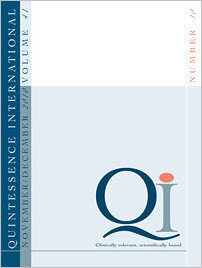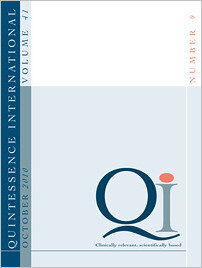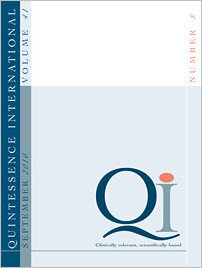Pages 719, Language: EnglishEliav, EliPubMed ID (PMID): 21909496Pages 721-728, Language: EnglishGeckili, Onur / Bilhan, Hakan / Mumcu, EmreObjective: To evaluate three-implant-retained mandibular overdentures after 3 years in terms of success rates, maximum occlusal force (MOF), marginal bone loss around implants (MBL), patient satisfaction, and quality of life (QoL).
Method and Materials: Twenty-three edentulous adults with maxillary complete dentures who received threeimplant- retained mandibular overdentures with ball or bar attachments by the same surgeon over a 1-year period were evaluated 3 years after overdenture loading. Subjects were asked to grade their three-implant-retained mandibular overdentures on a visual analog scale and to complete the short-form Oral Health Impact Profile (OHIP-14) to evaluate satisfaction and QoL. MBL was evaluated using panoramic radiography. MOF with and without implant support was recorded using a strain gauge. Overall success was measured by absence of mobility, peri-implant radiolucency, pain and paresthesia, and progressive MBL.
Results: The overall success rate of implants was 100%. MBL around center implants was lower than around implants on the right and left sides (P = .001 and P =.03, respectively). MOF without implant support was lower than with implant support (P =.001). There was no association between attachment type and either MBL, MOF, satisfaction, or QoL (P > .05).
Conclusion: The excellent outcomes for three-implant-retained mandibular overdentures indicate that, regardless of attachment type, three-implant- retained mandibular overdentures opposing complete dentures are a successful treatment option for edentulous adults.
Keywords: dental implant, mandibular overdenture, marginal bone loss, maximum occlusal force, patient satisfaction, quality of life
PubMed ID (PMID): 21909497Pages 729-735, Language: EnglishMonteiro de Castro, José Carlos / Poi, Wilson Roberto / Pedrini, Denise / Tiveron, Adelisa Rodolfo Ferreira / Brandini, Daniela Atili / de Castro, Mara Antônio MonteiroCrown-root fractures in permanent teeth cause esthetic and functional problems. This paper reports the case of a complicated crown-root fracture in the maxillary right central incisor of a young patient who was treated with a multidisciplinary approach in two phases. A modified Widman flap, root canal therapy, glass fiber post cementation, and adhesive tooth fragment reattachment were performed shortly after an accident. Satisfactory esthetic and functional outcomes were obtained. However, the patient did not attend follow-up visits and returned after 7 years. During this second phase, the clinical and radiographic examination showed stability and adaptation of the fragment and good periodontal health conditions, but crown darkening and a radiolucent image associated with the root apex of the fractured tooth were also observed. The periapical lesion was surgically removed by apicoectomy, and the esthetics were recovered with a direct composite resin veneer on the traumatized tooth.
Keywords: dental bonding, patient care planning, tooth fractures, tooth injuries
PubMed ID (PMID): 21909498Pages 737-743, Language: EnglishArtzi, Zvi / Chaturvedi, RashiA dual mucogingival treatment is presented in which severely traumatized maxillary central incisors sustained lateral and extrusive luxation injuries in a roadside accident. Injuries resulted in complete loss of the overlying radicular labial cortical plate followed by a gingival soft tissue cleft, which created a Grade II Miller recession defect in relation to the labial aspect of the maxillary central incisors. A multidisciplinary treatment approach was used, including emergency care, endodontic therapy, and sequential dual periodontal soft tissue rehabilitation. Subepithelial connective tissue grafting was carried out using two techniques, which proved successful in achieving complete coverage of the defect sites. This two-stage surgical approach enabled achievement of ample vascularization for soft tissue grafting and enhanced its predictability for optimal outcome. At the 3-year follow-up, clinical and radiographic examination showed a maintainable functional and esthetic status.
Keywords: connective tissue graft, luxation injury, mucogingival surgery, recession, soft tissue management, trauma
PubMed ID (PMID): 21909499Pages 745-752, Language: EnglishTakita, Toshiya / Tsurumachi, Tamotsu / Ogiso, BunnaiThis case report presents the endodontic treatment of a maxillary right lateral incisor with a perforating internal resorption in a 50-year-old woman. Radiographically, internal resorption appears as a fairly uniform, radiolucent enlargement of the pulp canal and distortion of the original root canal outline. The use of cone beam computed tomography can help the clinician in making a confirmatory diagnosis and determining the treatment plan before undertaking the actual treatment. After cleaning the root canal space and the resorptive defect by mechanic instrumentation, irrigation, and interim calcium hydroxide dressing, the apical third canal was filled with a gutta-percha point by lateral condensation. The resorptive defect was filled with mineral trioxide aggregate. Follow-up radiographs at 3 years showed adequate repair of the resorption, and the tooth remained asymptomatic.
Keywords: cone beam computed tomography, mineral trioxide aggregate, perforating internal resorption
PubMed ID (PMID): 21909500Pages 753-760, Language: EnglishSplieth, Christian H. / Berndt, Christine / Alkilzy, Mohammad / Treuner, AnjaObjective: Fluoride is the most important factor in the decline of caries in children and adolescents. The aim of this observational study, begun in 2000, was to assess the effect of semiannual topical fluoride application in schoolchildren.
Method and Materials: Due to limited resources, only 334 of all first and second grade schoolchildren (6 to 8 years of age, 0.32 ± 1.02 decayed/missing/filled surface [DMFS], schools randomly selected) in Greifswald received a semiannual application of elmex fluid, while the remaining 442 children served as the control group (0.36 ± 1.15 DMFS). In 2002 and 2004, 230 and 349 of these children were re-examined according to WHO criteria by one calibrated examiner (DMFT/S). The parents filled out questionnaires on additional fluoride use, which was summarized as fluoride scores. In the dropout analysis, a selection bias among the dropout, fluoride, and control group regarding age, baseline caries prevalence, additional fluoride use, and sealants was excluded.
Results: During the entire study, no adverse effects were recorded with the use of elmex fluid. The caries increment was almost identical in the intervention and control groups (0.81 ± 1.74 and 0.78 ± 1.81 DMFS) with 72% and 69% of the children, respectively, showing no caries increment. The effect of only two applications of elmex fluid might have been overridden by the high background fluoride use. The participants had high mean values of the fluoride scores, reflecting the regular use of fluoride toothpaste and additional fluoride sources, without a polarization within the sample (intervention, 1.40 ± 0.60; control, 1.33 ± 0.60).
Conclusion: Further studies should examine the effect of semiannual topical fluoride applications after caries decline.
Keywords: caries, efficacy, fluoride, prevention, topical fluoride
PubMed ID (PMID): 21909501Pages 761-769, Language: EnglishMonini, André da Costa / Martins, Renato Parsekian / Martins, Isabela Parsekian / Martins, Lidia ParsekianParesthesia of the lower lip is uncommon during orthodontic treatment. In the present case, paresthesia occurred during orthodontic leveling of an extruded mandibular left second molar. It was decided to remove this tooth from the appliance and allow it to relapse. A reanatomization was then performed by grinding. The causes and treatment options of this rare disorder are reviewed and discussed. The main cause of paresthesia during orthodontic treatment may be associated with contact between the dental roots and inferior alveolar nerve, which may be well observed on tomography scans. Treatment usually involves tooth movement in the opposite direction of the cause of the disorder.
Keywords: orthodontic appliances, paresthesia
PubMed ID (PMID): 21909502Pages 771-779, Language: EnglishJaiswal, Shradha G. / Gadbail, Amol R. / Chaudhary, Minal S. / Jaiswal, Gagan R. / Gawande, MadhuriObjective: This study aimed to assess the serum levels of vascular endothelial growth factor in oral squamous cell carcinoma patients before and after surgical therapy, to compare these values with those of healthy individuals using ELISA, and to evaluate if any correlation existed between vascular endothelial growth factor levels and TNM stage or histolopathologic grade of the tumor.
Method and Materials: The study included three groups: group A1 consisted of 31 oral squamous cell carcinoma patients who had not received any prior treatment; group A2 consisted of the same 31 oral squamous cell carcinoma patients who had undergone radical surgical excision 1 month prior but no adjuvant therapy; and group B (control group) consisted of 16 healthy individuals. The serum vascular endothelial growth factor levels were assessed using the ELISA kit.
Results: The vascular endothelial growth factor levels of preoperative oral squamous cell carcinoma patients were found to be three times higher than those of controls, and this difference was found to be statistically significant. The postoperative vascular endothelial growth factor levels had decreased 1 month after surgery but did not decrease to baseline levels. The vascular endothelial growth factor levels increased progressively with the TNM stage and histologic grade of tumor, but no definite correlation between the two could be found.
Conclusion: Vascular endothelial growth factor is an important marker of angiogenesis, as the vascular endothelial growth factor levels of the oral squamous cell carcinoma groups remained significantly elevated compared to that of controls. Though no significant difference was found between the pre- and postoperative oral squamous cell carcinoma groups, it can be suggested that successful treatment may reduce serum vascular endothelial growth factor levels if the time period of postoperative sample collection is increased. Only then can the utility of vascular endothelial growth factor as marker for assessing the effectiveness of surgical therapy or as a prognostic indicator be commented upon.
Keywords: angiogenesis, ELISA, oral squamous cell carcinoma, serum
PubMed ID (PMID): 21909503Pages 781-785, Language: EnglishZigdon, Hadar / Gutmacher, Zvi / Teich, Sorin / Levin, LiranScleroderma is an autoimmune multisystem rheumatic condition that affects connective tissues. Oral manifestations of the disease are directly relevant to the dental and periodontal diagnosis, treatment plan, and management of patients diagnosed with scleroderma. In the presented case, progressive limitation of mouth opening together with severe caries and periodontal disease warranted a fixed implant-supported rehabilitation using dental implants. Three-year follow-up revealed good oral hygiene and clinical appearance with no radiologic evidence of bone loss around the implants. Implant-supported rehabilitation might be a viable treatment option in patients with scleroderma under chronic use of systemic steroids. Further studies with long-term follow-up are warranted.
Keywords: implant failure, implant survival, systemic sclerosis, systemic steroids
PubMed ID (PMID): 21909504Pages 787-796, Language: EnglishTang, Lu / Zhou, Xue-dong / Wang, Qian / Zhang, Lan / Wang, Yao / Huang, Ding-MingObjective: Periodontitis is a group of inflammatory diseases caused by microorganisms. Porphyromonas gingivalis, a gram-negative bacteria, is strongly associated with the onset of periodontitis. Tumor necrosis factor (TNF) receptor-associated factor 6 (TRAF6) represents an important target in the regulation of many disease processes, including immunity, inflammation, and osteoporosis. The aim of this study was to investigate the role of TRAF6 for inflammatory response in P gingivalis-infected human periodontal ligament cells (HPDLCs).
Method and Materials: HPDLCs were stimulated with 1 × 108 CFU/mL P gingivalis, or 10 µg/mL P gingivalis lipopolysaccharide (LPS), separately in the absence or presence of small interfering RNA (siRNA) for TRAF6. The expression of TRAF6 was examined by real-time polymerase chain reaction and Western blot analysis. Concentrations of IL-1ß, IL-6, and IL-8 in the culture supernatants were determined by enzyme-linked immunosorbent assay (ELISA).
Results: In this study, we found that both P gingivalis and its LPS treatment increased the expression of TRAF6 and proinflammatory cytokine production in HPDLCs. In addition, we used siRNA for TRAF6, and the inhibition of TRAF6 expression reduced the production of proinflammatory cytokines in HPDLCs stimulated with P gingivalis and its LPS.
Conclusion: The results suggested that TRAF6 may be a key molecule to control proinflammatory cytokine production induced by P gingivalis and its LPS. TRAF6 suppression may inhibit inflammatory responses in HPDLCs infected by P gingivalis and its LPS.
Keywords: human periodontal ligament cells, periodontitis, Porphyromonas gingivalis, proinflammatory cytokines, tumor necrosis factor (TNF) receptor-associated factor 6
PubMed ID (PMID): 21909505Pages 797-804, Language: EnglishMiletec, Vesna / Manojlovic, Dragica / Milosevic, Milos / Mitrovic, Nenad / Stankovic, Tatjana Savic / Maneski, TaskoObjective: To analyze local shrinkage patterns in terms of surface shrinkage strains and z-axis displacements in a novel self-adhering composite and a conventional flowable composite using three-dimensional digital image correlation.
Method and Materials: Seven samples of each material were prepared in cylindrical Teflon molds 5 mm in diameter and 2 mm thick. The surface of the composites facing the cameras was sprayed with a fine layer of black paint. The unsprayed surface of each sample, opposite the one facing the cameras, was light cured for 40 seconds using a light-emitting diode unit. Digital images were taken immediately before and after light curing. Shrinkage was calculated as von Mises strains, and z-axis displacements were measured in microns. The data were statistically analyzed using two-way ANOVA at α = .05.
Results: No significant difference in strain was observed between the two materials (P > .05). Strain distribution was nonhomogenous- the outer segments showed significantly higher strains than central parts in each material (P .05). The opposite was observed for z-axis displacements-significantly greater displacements were found in central parts compared to the outer segments (P .05).
Conclusion: Different shrinkage vectors across the surface of the tested flowable composites showed predominant in-plane shrinkage of the outer surface segments and out-of-plane shrinkage of the inner segments. These complex local deformation patterns in composite materials indicate zones of different types of forces exerted on the tooth-restoration interface in situ.
Keywords: 3D measurement, digital image correlation, flowable composite, polymerization, shrinkage, strain
Online OnlyPubMed ID (PMID): 21909495Pages 805, Language: EnglishYousry, Mai Mahmoud / ElNaga, Abeer Abo / Hafez, Randa M. / El-Badrawy, WafaObjective: To compare microshear bond strength (µSBS) of two pairs of etch-and-rinse and self-etch adhesives to superficial and deep dentin.
Method and Materials: Occlusal surfaces of 40 sound extracted noncarious human molars were ground to obtain flat dentin surfaces (20 superficial and 20 deep dentin). Twenty-four teeth were used for µSBS test and 16 for scanning electron microscopic examination. Each dentin group was randomly assigned into four groups, according to the adhesive system tested. An etchand- rinse and a self-etch adhesive from the same manufacturer were utilized: Scotchbond-MultiPurpose and Adper-Scotchbond SE and XP Bond and Xeno IV. CeramX was used for composite microcylinder construction (0.9 mm in diameter and 0.7 mm in height). Five composite microcylinders were constructed on each dentin surface (n = 15 per group). A Lloyd universal testing machine was used to test µSBS at a crosshead speed of 0.5 mm/min. Fractographic analysis of the failure site was performed using a stereomicroscope and measured by image-analysis software. Data were statistically analyzed using ANOVA and Duncan tests.
Results: In superficial dentin, Xeno IV showed significantly the highest µSBS, while in deep dentin, XP Bond showed the highest µSBS. The lowest µSBS values in both dentin depths were recorded for Adper- Scotchbond SE. Etch-and-rinse systems bonded better to deep than to superficial dentin, while self-etching systems showed similar performance at both dentin depths.
Conclusion: Bond strength to dentin is both adhesive- and substrate-dependent. Contemporary adhesive systems may produce variable bonding results to superficial and deep dentin due to variations in their composition rather than their bonding approach or application technique.
Keywords: dentin bond strength, etch-and-rinse adhesives, self-etch adhesives, SEM
Online OnlyPubMed ID (PMID): 21909493Pages 805, Language: EnglishKnöfler, Gerhild U. / Purschwitz, Regina E. / Eick, Sigrun / Pfister, Wolfgang / Roedel, Mirjam / Jentsch, Holger F. R.Objective: To investigate the impact on microbiologic variables of full-mouth scaling (FMS) and conventional scaling and root planing (cSRP) after 12 months.
Method and Materials: In a prospective randomized controlled clinical study, 37 volunteers with moderate chronic periodontitis were treated by FMS or by cSRP in two sessions at 4-week intervals. Clinical attachment level, probing depth, and bleeding on probing were recorded at baseline as well as at 6 and 12 months. Four subgingival plaque samples were taken from the deepest sites in premolars and molars at baseline and after 12 months. Pooled sample analysis was performed using real-time polymerase chain reaction for the identification of Aggregatibacter actinomycetemcomitans, Porphyromonas gingivalis, Tannerella forsythia, and Treponema denticola.
Results: At baseline, the bacterial load of A actinomycetemcomitans was significantly higher in the cSRP group compared to the FMS group (P = .042). In the cSRP group, this load decreased significantly (P = .011), leading to similar quantities of A actinomycetemcomitans in both groups. Further, significant reductions in frequency were found in the FMS group for T forsythia and P gingivalis and in the cSRP group for A actinomycetemcomitans and T denticola.
Conclusion: The data suggest that both therapy modalities lead to similar effects on target periodontal pathogen species. FMS compared to cSRP was not favorable in reduction of periodontopathogens.
Keywords: microbiologic analysis, nonsurgical therapy, periodontal disease, randomized clinical trial
Online OnlyPubMed ID (PMID): 21909494Pages 806, Language: EnglishByakodi, Raghavendra / Krishnappa, R. / Keluskar, Vaishali / Bagewadi, Anjana / Shetti, ArvindObjective: Changes in the microbial flora on the oral mucosa after cancerous alteration may lead to both local and systemic infections. In this study, we assessed the microbial flora associated with the surfaces of oral squamous cell carcinoma. A comparative evaluation of these microbial contents was made with that of the contralateral healthy mucosa and control (healthy) mucosa. We also assessed the microbial flora from the saliva culture in subjects with oral squamous cell carcinoma and healthy controls.
Method and Materials: The case control study was made up of 30 subjects with oral squamous cell carcinoma as the study group; 30 healthy age-, sex-, habit-, and dentition-matched subjects served as the control group. In the study group, microbial samples were collected from the carcinoma site, contralateral healthy mucosa, and saliva, whereas in the control group, samples were collected from the healthy mucosa and saliva. These samples were stored on ice and subsequently transported to the laboratory in 2 mL of thioglycollate transport media, where the microbial cultures were carried out.
Results: Oral squamous cell carcinoma sites harbor significantly more microbial flora (bacteria and yeasts) compared to those of healthy mucosa (control group). The microbial flora predominantly isolated from the carcinoma site were Streptococcus species, Staphylococcus species, Moraxella species, Enterococcus feacalis, Aerobic spore bearers, Klebsiella species, Citrobacter species, Proteus species, Pseudomonas species, and Candida albicans. The median number of colony forming units (CFU)/mL at carcinoma sites (3.85 × 105 CFU/mL) was significantly higher than that of the healthy mucosa (0.571 × 105 CFU/mL; P = .0000, Wilcoxon nonparametric test). Similarly, in saliva of carcinoma subjects, the median number of CFU/mL (2.408 × 105 CFU/mL) was significantly higher than that of saliva in control subjects (0.78 × 105 CFU/mL; P = .0000, Wilcoxon nonparametric test).
Conclusion: The present study clearly indicates that the subjects with oral squamous cell carcinoma harbor significantly more microbial flora. Emphasis has to be given to preventing microbial flora in the oral cavity and treating these patients with appropriate antimicrobial agents, thus reducing their morbidity.
Keywords: bacteria, cancer, microbial flora, oral carcinoma, oral squamous cell carcinoma, yeasts



